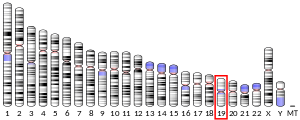
TM6SF2

53345107770ENSG00000213996ENSMUSG00000036151Q9BZW4Q8R1J1NM_203510NM_001001524NM_001293795NM_181540NP_001001524NP_001280724NP_853518TM6SF2 is the Transmembrane 6 superfamily 2 human gene which codes for a protein by the same name. This gene is otherwise called KIAA1926. Its exact function is currently unknown. TM6SF2 is the Transmembrane 6 superfamily 2 human gene which codes for a protein by the same name. This gene is otherwise called KIAA1926. Its exact function is currently unknown. TM6SF2 is located on chromosome 19 precisely at locus 19p13.3-p12. It is flanked by SUGP1 (a SURP and G-Patch Domain-Containing protein thought to play a role in pre-mRNA splicing ) and HAPLN4 (a hyaluronan and proteoglycan link protein 4 that binds to hyaluronic acid and may be involved in formation of the extracellular matrix ) genes upstream and downstream respectively. TM6SF2 is a moderately conserved gene. There exist orthologs in several phyla as far diverged as invertebrates. 82 organisms have been identified as having orthologs of this gene. The most distant orthologs of TM6SF2 are in zebra fish (Danio rerio) and the deer tick (Ixodes scapularis). Below is a summary table of some of the gene orthologs obtained from the NCBI database. TM6SF1 has been identified as a paralog of TM6SF2 in humans about which little is known. The domain of unknown function DUF2781 is highly conserved across homologs. DUF2781 belongs to the pfam10914 family which comprises uncharacterized eukaryotic proteins, some of which are membrane proteins The RNA product is 1483 base pairs long and is spliced alternatively to yield seven different isoforms (alternative mRNAs a - f with form a being the most abundant) with varying combinations of the 10 identified exons. The microRNA miR-1343 binds to a 3’ UTR site called 7mer-m8 (as predicted by TargetScan). The 5' and 3' UTR regions of the mRNA show some stem loop formation for stability. Much of this chemistry appears to be taking place in the 5' region which has three stem loops compared to the 3' region with only one. There are ten different exons and the ones expressed depend on how alternative splicing proceeds. There are four alternative polyadenylation sites present. The promoter for this gene is upstream and spans bases 19383923 to 19384700 (778 bp long) on the minus strand of chromosome 19. There exist several transcription factors capable of binding to this promoter region including cAMP responsive element binding protein, SMAD3, KLF3, EGR1, SOX/SRY, PAX2/PAX5 and two SNP regions have been identified as well. The transcription factors predicted to bind the TM6SF2 promoter suggest this protein functions in growth and tumor regulation as well as sex determination to a lesser extent.
